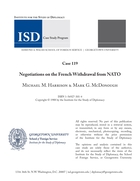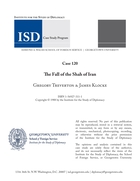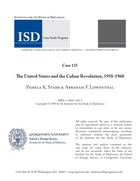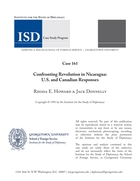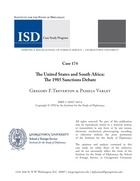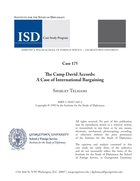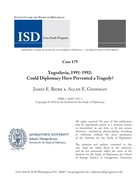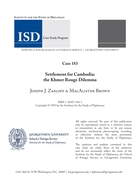Browse Titles - 27 results
Negotiations on the French Withdrawal from NATO
written by Mark G. McDonough, fl. 1988 and M. John Harrison, 1945-, in Institute for the Study of Diplomacy Case Study Program, Case 119 (District of Columbia: Georgetown University. School of Foreign Service. Institute for the Study of Diplomacy, 1988), 21 page(s)
This case study describes the negotiations accompanying the process of France’s withdrawal from the North Atlantic Treaty Organization’s integrated military system, including the expulsion of NATO units from French soil. It focuses on negotiations among allies who retain common political security interests, de...
Sample
written by Mark G. McDonough, fl. 1988 and M. John Harrison, 1945-, in Institute for the Study of Diplomacy Case Study Program, Case 119 (District of Columbia: Georgetown University. School of Foreign Service. Institute for the Study of Diplomacy, 1988), 21 page(s)
Description
This case study describes the negotiations accompanying the process of France’s withdrawal from the North Atlantic Treaty Organization’s integrated military system, including the expulsion of NATO units from French soil. It focuses on negotiations among allies who retain common political security interests, despite some strong differences concerning principles of national and Western defense. As such, the case is particularly useful for cours...
This case study describes the negotiations accompanying the process of France’s withdrawal from the North Atlantic Treaty Organization’s integrated military system, including the expulsion of NATO units from French soil. It focuses on negotiations among allies who retain common political security interests, despite some strong differences concerning principles of national and Western defense. As such, the case is particularly useful for courses on international negotiation and bargaining, and for courses involving alliance organizations and Western security affairs.
Show more
Show less
Field of Study
Global Issues
Content Type
Case study
Author / Creator
Mark G. McDonough, fl. 1988, M. John Harrison, 1945-
Date Published / Released
1988
Publisher
Georgetown University. School of Foreign Service. Institute for the Study of Diplomacy
Series
Institute for the Study of Diplomacy Case Study Program
Person Discussed
Charles de Gaulle, 1890-1970
Topic / Theme
France and its Borders, Negotiation in government, Military alliances, International relations, Civil defense, Politics & Policy, British, Americans, French, 20th Century in World History (1914--2000)
Copyright Message
Copyright © 1988 The Institute for the Study of Diplomacy
×
The Fall of the Shah of Iran
written by James Klocke, fl. 1988 and Gregory F. Treverton, 1947-, in Institute for the Study of Diplomacy Case Study Program, Case 120 (District of Columbia: Georgetown University. School of Foreign Service. Institute for the Study of Diplomacy, 1988), 15 page(s)
This case study examines the impact of intelligence assessments on U.S. decision-making with regard to Iran, both prior to the ouster of the shah in early 1979 and afterward. It discusses American interests in the Persian Gulf and policymaking on critical regional security issues, by focusing on the presumptions,...
Sample
written by James Klocke, fl. 1988 and Gregory F. Treverton, 1947-, in Institute for the Study of Diplomacy Case Study Program, Case 120 (District of Columbia: Georgetown University. School of Foreign Service. Institute for the Study of Diplomacy, 1988), 15 page(s)
Description
This case study examines the impact of intelligence assessments on U.S. decision-making with regard to Iran, both prior to the ouster of the shah in early 1979 and afterward. It discusses American interests in the Persian Gulf and policymaking on critical regional security issues, by focusing on the presumptions, most of them implicit, of policymakers. When used in general international relations courses, the case can also serve as a vehicle for...
This case study examines the impact of intelligence assessments on U.S. decision-making with regard to Iran, both prior to the ouster of the shah in early 1979 and afterward. It discusses American interests in the Persian Gulf and policymaking on critical regional security issues, by focusing on the presumptions, most of them implicit, of policymakers. When used in general international relations courses, the case can also serve as a vehicle for examining the record of the U.S. government on handling a crucial national security challenge. It could usefully be paired with “A King’s Exile: The Shah of Iran and Moral Considerations in U.S. Foreign Policy” (Case Study 261). In addition, “The Fall of Marcos: A Problem in U.S. Foreign Policymaking” (Case Study 173) covers a similar dilemma.
Show more
Show less
Field of Study
Global Issues
Content Type
Case study
Author / Creator
James Klocke, fl. 1988, Gregory F. Treverton, 1947-
Date Published / Released
1988
Publisher
Georgetown University. School of Foreign Service. Institute for the Study of Diplomacy
Series
Institute for the Study of Diplomacy Case Study Program
Person Discussed
Henry Precht, 1932-, Gary G. Sick, 1935-, William H. Sullivan, 1922-2013, George W. Ball, 1909-1994, Zbigniew Kazimierz Brzezinski, 1928-, Ruhollah Mussavi Khomeini, 1902-1989, Jimmy Carter, 1924-, Richard Milhous Nixon, 1913-1994, Mohammad Reza Pahlavi, Shah of Iran, 1919-1980
Topic / Theme
Iranian Revolutions 1953-1979, Human rights, Government policy, International relations, Military aid, Iranian Revolution, 1978-1979, Diplomacy, Politics & Policy, Iranians, 20th Century in World History (1914--2000)
Copyright Message
Copyright © 1988 The Institute for the Study of Diplomacy
×
The United States and the Cuban Revolution, 1958-1960
written by Abraham F. Lowenthal, 1941- and Pamela K. Starr, fl. 1988, in Institute for the Study of Diplomacy Case Study Program, Case 125 (District of Columbia: Georgetown University. School of Foreign Service. Institute for the Study of Diplomacy, 1988), 26 page(s)
The recurrent rise of revolutionary movements in Latin America has long posed a difficult problem for those who formulate U.S. foreign policy: How can U.S. interests be best protected when radical movements threaten to end its historic domination of its “sphere of influence?” This case study of Washington’s...
Sample
written by Abraham F. Lowenthal, 1941- and Pamela K. Starr, fl. 1988, in Institute for the Study of Diplomacy Case Study Program, Case 125 (District of Columbia: Georgetown University. School of Foreign Service. Institute for the Study of Diplomacy, 1988), 26 page(s)
Description
The recurrent rise of revolutionary movements in Latin America has long posed a difficult problem for those who formulate U.S. foreign policy: How can U.S. interests be best protected when radical movements threaten to end its historic domination of its “sphere of influence?” This case study of Washington’s response as Fidel Castro moved to seize power in Havana looks at conflicting perceptions and objectives with regard to Cuba, and the de...
The recurrent rise of revolutionary movements in Latin America has long posed a difficult problem for those who formulate U.S. foreign policy: How can U.S. interests be best protected when radical movements threaten to end its historic domination of its “sphere of influence?” This case study of Washington’s response as Fidel Castro moved to seize power in Havana looks at conflicting perceptions and objectives with regard to Cuba, and the degree to which U.S. policy was affected by the level of government from which particular decisions came.
Show more
Show less
Field of Study
Global Issues
Content Type
Case study
Author / Creator
Abraham F. Lowenthal, 1941-, Pamela K. Starr, fl. 1988
Date Published / Released
1988
Publisher
Georgetown University. School of Foreign Service. Institute for the Study of Diplomacy
Series
Institute for the Study of Diplomacy Case Study Program
Person Discussed
Richard Milhous Nixon, 1913-1994, Fulgencio Batista, 1901-1973, Fidel Castro, 1926-2016
Topic / Theme
Cuban Revolution and Fidel Castro Regime, 1953-2011, Communism, Government policy, International relations, Cuban War of Independence, 1895-1898, Cuban Revolution, 1956-1959, Politics & Policy, Cubans, 20th Century in World History (1914--2000)
Copyright Message
Copyright © 1988 The Institute for the Study of Diplomacy
×
Confronting Revolution in Nicaragua: US and Canadian Responses
written by Jack Donnelly, fl. 1991 and Rhoda E. Howard, fl. 1992, in Institute for the Study of Diplomacy Case Study Program, Case 161 (District of Columbia: Georgetown University. School of Foreign Service. Institute for the Study of Diplomacy, 1991), 17 page(s)
This case study, created for the Carnegie Council on Ethics and International Affairs, analyzes the differences between U.S. policy toward Nicaragua and Canada’s approach during the final years of the Cold War. It focuses on the period from 1977 to 1990, when the administrations of Jimmy Carter, Ronald Reagan, a...
Sample
written by Jack Donnelly, fl. 1991 and Rhoda E. Howard, fl. 1992, in Institute for the Study of Diplomacy Case Study Program, Case 161 (District of Columbia: Georgetown University. School of Foreign Service. Institute for the Study of Diplomacy, 1991), 17 page(s)
Description
This case study, created for the Carnegie Council on Ethics and International Affairs, analyzes the differences between U.S. policy toward Nicaragua and Canada’s approach during the final years of the Cold War. It focuses on the period from 1977 to 1990, when the administrations of Jimmy Carter, Ronald Reagan, and George H.W. Bush contended with revolution and Sandinista rule in Nicaragua.
Field of Study
Global Issues
Content Type
Case study
Author / Creator
Jack Donnelly, fl. 1991, Rhoda E. Howard, fl. 1992
Date Published / Released
1991
Publisher
Georgetown University. School of Foreign Service. Institute for the Study of Diplomacy
Series
Institute for the Study of Diplomacy Case Study Program
Person Discussed
Luis Somoza, 1922-1967, Anastasio Somoza, 1896-1956, Ronald Reagan, 1911-2004, Jimmy Carter, 1924-
Topic / Theme
Nicaraguan Revolution, 1962-1990, Human rights, Government policy, International relations, Somoza Government Overthrown, Nicaragua, July 19, 1979, Nicaraguan Revolution, 1960s-1990, Politics & Policy, Nicaraguans, 20th Century in World History (1914--2000)
Copyright Message
Copyright © 1991 The Institute for the Study of Diplomacy
×
The US and South Africa: The 1985 Sanctions Debate
written by Pamela Varley, fl. 1992 and Gregory F. Treverton, 1947-, in Institute for the Study of Diplomacy Case Study Program, Case 174 (District of Columbia: Georgetown University. School of Foreign Service. Institute for the Study of Diplomacy, 1992), 27 page(s)
This case study begins with a brief background on South Africa in the early 1980s and the Reagan administration’s policy of constructive engagement. It then traces the South African riots in the fall of 1984, ending with President Reagan’s fall 1985 executive order to impose mild sanctions against South Africa...
Sample
written by Pamela Varley, fl. 1992 and Gregory F. Treverton, 1947-, in Institute for the Study of Diplomacy Case Study Program, Case 174 (District of Columbia: Georgetown University. School of Foreign Service. Institute for the Study of Diplomacy, 1992), 27 page(s)
Description
This case study begins with a brief background on South Africa in the early 1980s and the Reagan administration’s policy of constructive engagement. It then traces the South African riots in the fall of 1984, ending with President Reagan’s fall 1985 executive order to impose mild sanctions against South Africa. The case is designed to give students of international affairs a chance to discuss the multitude of factors that influence bilateral...
This case study begins with a brief background on South Africa in the early 1980s and the Reagan administration’s policy of constructive engagement. It then traces the South African riots in the fall of 1984, ending with President Reagan’s fall 1985 executive order to impose mild sanctions against South Africa. The case is designed to give students of international affairs a chance to discuss the multitude of factors that influence bilateral relations—and prompt shifts in foreign policy.
Show more
Show less
Field of Study
Global Issues
Content Type
Case study
Author / Creator
Pamela Varley, fl. 1992, Gregory F. Treverton, 1947-
Date Published / Released
1992
Publisher
Georgetown University. School of Foreign Service. Institute for the Study of Diplomacy
Series
Institute for the Study of Diplomacy Case Study Program
Person Discussed
Ronald Reagan, 1911-2004, Nancy Kassebaum Baker, 1932-, Richard Lugar, 1932-, Chester A. Crocker, 1941-, Pierter Willem Botha, 1916-2006
Topic / Theme
South African Apartheid (1948-1994), International sanctions, Race relations, Government policy, Politics & Policy, Diplomacy, International Response, South Africans, 20th Century in World History (1914--2000)
Copyright Message
Copyright © 1992 The Institute for the Study of Diplomacy
×
The Camp David Accords: A Case of International Bargaining
written by Shibley Telhami, 1951-, in Institute for the Study of Diplomacy Case Study Program, Case 175 (District of Columbia: Georgetown University. School of Foreign Service. Institute for the Study of Diplomacy, 1992, originally published 1992), 41 page(s)
This case study examines the process that led to the signing of the 1978 Camp David Accords between Egypt and Israel, with the United States playing a central role. Exploring international negotiations at their most elevated level, this study allows students to trace a series of evolving positions based on several...
Sample
written by Shibley Telhami, 1951-, in Institute for the Study of Diplomacy Case Study Program, Case 175 (District of Columbia: Georgetown University. School of Foreign Service. Institute for the Study of Diplomacy, 1992, originally published 1992), 41 page(s)
Description
This case study examines the process that led to the signing of the 1978 Camp David Accords between Egypt and Israel, with the United States playing a central role. Exploring international negotiations at their most elevated level, this study allows students to trace a series of evolving positions based on several variables. It could be used in courses on Middle East affairs, international diplomacy and bargaining, or decision-making theory.
Field of Study
Global Issues
Content Type
Case study
Author / Creator
Shibley Telhami, 1951-
Date Published / Released
1992
Publisher
Georgetown University. School of Foreign Service. Institute for the Study of Diplomacy
Series
Institute for the Study of Diplomacy Case Study Program
Topic / Theme
Israeli-Palestinian Conflict (1948 -- ), International relations, Camp David Accords, 1978, Diplomacy, International Response, Egyptians, Israelis, Palestinians, 20th Century in World History (1914--2000)
Copyright Message
Copyright © 1992 The Institute for the Study of Diplomacy
×
Yugoslavia, 1991-1992: Could Diplomacy Have Prevented a Tragedy?
written by Allan E. Goodman, 1944- and James E. Bjork, fl. 1992, in Institute for the Study of Diplomacy Case Study Program, Case 179 (District of Columbia: Georgetown University. School of Foreign Service. Institute for the Study of Diplomacy, 1992), 22 page(s)
The disintegration of Yugoslavia in the early 1990s was a reminder that the end of the Cold War did not automatically make the world more orderly. As brinkmanship among top political leaders in the constituent republics precipitated a descent into brutal ethnic warfare, U.S., European, and U.N. diplomatic efforts...
Sample
written by Allan E. Goodman, 1944- and James E. Bjork, fl. 1992, in Institute for the Study of Diplomacy Case Study Program, Case 179 (District of Columbia: Georgetown University. School of Foreign Service. Institute for the Study of Diplomacy, 1992), 22 page(s)
Description
The disintegration of Yugoslavia in the early 1990s was a reminder that the end of the Cold War did not automatically make the world more orderly. As brinkmanship among top political leaders in the constituent republics precipitated a descent into brutal ethnic warfare, U.S., European, and U.N. diplomatic efforts failed to forestall the conflict. This case study conveys the difficulties negotiators faced in dealing with the Yugoslav crisis, chall...
The disintegration of Yugoslavia in the early 1990s was a reminder that the end of the Cold War did not automatically make the world more orderly. As brinkmanship among top political leaders in the constituent republics precipitated a descent into brutal ethnic warfare, U.S., European, and U.N. diplomatic efforts failed to forestall the conflict. This case study conveys the difficulties negotiators faced in dealing with the Yugoslav crisis, challenging students to consider other diplomatic options.
Show more
Show less
Field of Study
Global Issues
Content Type
Case study
Author / Creator
Allan E. Goodman, 1944-, James E. Bjork, fl. 1992
Date Published / Released
1992
Publisher
Georgetown University. School of Foreign Service. Institute for the Study of Diplomacy
Series
Institute for the Study of Diplomacy Case Study Program
Topic / Theme
Yugoslav Wars: Bosniaks, Serbs, Croats (1991-1995), Peacekeeping, Ethnic conflict, International relations, Bosnian War, Bosnia and Herzegovina, 1992-1995, Yugoslav Wars, 1992-1995, Diplomacy, International Response, Bosnians, Serbians, Croatians, 20th Century in World History (1914--2000)
Copyright Message
Copyright © 1992 The Institute for the Study of Diplomacy
×
Settlement for Cambodia: The Khmer Rouge Dilemma
written by Macalister Brown, fl. 1993 and Joseph J. Zasloff, 1914-2003, in Institute for the Study of Diplomacy Case Study Program, Case 183 (District of Columbia: Georgetown University. School of Foreign Service. Institute for the Study of Diplomacy, 1993), 24 page(s)
As this case study explains, the search for a comprehensive political settlement in Cambodia was complicated by the fact that it was simultaneously a national, regional, great power, and United Nations issue. The world tried a variety of diplomatic methods during the 1980s to resolve the situation, ranging from a...
Sample
written by Macalister Brown, fl. 1993 and Joseph J. Zasloff, 1914-2003, in Institute for the Study of Diplomacy Case Study Program, Case 183 (District of Columbia: Georgetown University. School of Foreign Service. Institute for the Study of Diplomacy, 1993), 24 page(s)
Description
As this case study explains, the search for a comprehensive political settlement in Cambodia was complicated by the fact that it was simultaneously a national, regional, great power, and United Nations issue. The world tried a variety of diplomatic methods during the 1980s to resolve the situation, ranging from a special U.N. conference in 1981 to informal contacts among the leading personalities, special meetings of the five permanent members of...
As this case study explains, the search for a comprehensive political settlement in Cambodia was complicated by the fact that it was simultaneously a national, regional, great power, and United Nations issue. The world tried a variety of diplomatic methods during the 1980s to resolve the situation, ranging from a special U.N. conference in 1981 to informal contacts among the leading personalities, special meetings of the five permanent members of the Security Council, mediation by the U.N. secretary general, and formal negotiating conferences in Paris, Jakarta, and Tokyo. This study examines the process that would eventually lead to a Cambodian settlement, and encourages students to assess why compromise was so elusive and which actors were most responsible for the impasse.
Show more
Show less
Field of Study
Global Issues
Content Type
Case study
Author / Creator
Macalister Brown, fl. 1993, Joseph J. Zasloff, 1914-2003
Date Published / Released
1993
Publisher
Georgetown University. School of Foreign Service. Institute for the Study of Diplomacy
Series
Institute for the Study of Diplomacy Case Study Program
Topic / Theme
Cambodia Khmer Rouge Regime (1975-1979), Peace processes, International relations, Government policy, Negotiation in government, Cambodian Civil War, 1970-1975, Cambodian Holocaust, 1975-1979, Diplomacy, History, Transitional Justice, Vietnamese, Cambodian, 20th Century in World History (1914--2000)
Copyright Message
Copyright © 1993 The Institute for the Study of Diplomacy
×
United States-Canadian Negotiations for Acid Rain Controls
written by Terry Forrest Young, fl. 1993 and Vicki Golich, fl. 1993, in Institute for the Study of Diplomacy Case Study Program, Case 186 (District of Columbia: Georgetown University. School of Foreign Service. Institute for the Study of Diplomacy, 1993), 37 page(s)
This case study uses the U.S.-Canada acid rain dispute of the 1980s to draw important lessons for students, scholars, and practitioners of international relations. It explains factors common to most international conflicts, such as an asymmetrical distribution of effects, the asymmetrical distribution of power, th...
Sample
written by Terry Forrest Young, fl. 1993 and Vicki Golich, fl. 1993, in Institute for the Study of Diplomacy Case Study Program, Case 186 (District of Columbia: Georgetown University. School of Foreign Service. Institute for the Study of Diplomacy, 1993), 37 page(s)
Description
This case study uses the U.S.-Canada acid rain dispute of the 1980s to draw important lessons for students, scholars, and practitioners of international relations. It explains factors common to most international conflicts, such as an asymmetrical distribution of effects, the asymmetrical distribution of power, the absence of a supranational authority, and disparate political cultures. The study then uses the acid rain negotiations to identify ad...
This case study uses the U.S.-Canada acid rain dispute of the 1980s to draw important lessons for students, scholars, and practitioners of international relations. It explains factors common to most international conflicts, such as an asymmetrical distribution of effects, the asymmetrical distribution of power, the absence of a supranational authority, and disparate political cultures. The study then uses the acid rain negotiations to identify additional factors found in nearly all environmental disputes: commonly held resource characteristics, technical complexity, and scientific or economic uncertainty. This case distills these factors into an engaging narrative of U.S. and Canadian environmental policies of the 1980s.
Show more
Show less
Field of Study
Global Issues
Content Type
Case study
Author / Creator
Terry Forrest Young, fl. 1993, Vicki Golich, fl. 1993
Date Published / Released
1993
Publisher
Georgetown University. School of Foreign Service. Institute for the Study of Diplomacy
Series
Institute for the Study of Diplomacy Case Study Program
Topic / Theme
Negotiation in government, Air pollution, International relations, Environmental policy, Law, Ecology, Politics & Policy, 20th Century in World History (1914--2000)
Copyright Message
Copyright © 1993 The Institute for the Study of Diplomacy
×
Restraint or Retaliation? Israel’s Response to the Iraqi Missile Attacks During the 1991 Gulf War
written by Laura Zittrain Eisenberg, fl. 1994, in Institute for the Study of Diplomacy Case Study Program, Case 192 (District of Columbia: Georgetown University. School of Foreign Service. Institute for the Study of Diplomacy, 1994), 16 page(s)
This case study describes Israeli interests and goals during the 1991 Gulf War and how these objectives informed its response to Iraqi missile attacks. It explains that Israeli interests were comprised of six guiding principles: the safety of the state and its citizens, the destruction of the Iraqi military machin...
Sample
written by Laura Zittrain Eisenberg, fl. 1994, in Institute for the Study of Diplomacy Case Study Program, Case 192 (District of Columbia: Georgetown University. School of Foreign Service. Institute for the Study of Diplomacy, 1994), 16 page(s)
Description
This case study describes Israeli interests and goals during the 1991 Gulf War and how these objectives informed its response to Iraqi missile attacks. It explains that Israeli interests were comprised of six guiding principles: the safety of the state and its citizens, the destruction of the Iraqi military machine, a stronger bond with the U.S., improved relations between Israel and the international community, maintenance of a credible deterren...
This case study describes Israeli interests and goals during the 1991 Gulf War and how these objectives informed its response to Iraqi missile attacks. It explains that Israeli interests were comprised of six guiding principles: the safety of the state and its citizens, the destruction of the Iraqi military machine, a stronger bond with the U.S., improved relations between Israel and the international community, maintenance of a credible deterrent, and a new postwar environment for considering the Arab-Israeli conflict. Students are asked to consider how these principles influenced Israeli decision-making during the Gulf War and whether Israel successfully carried out its objectives.
Show more
Show less
Field of Study
Global Issues
Content Type
Case study
Author / Creator
Laura Zittrain Eisenberg, fl. 1994
Date Published / Released
1994
Publisher
Georgetown University. School of Foreign Service. Institute for the Study of Diplomacy
Series
Institute for the Study of Diplomacy Case Study Program
Topic / Theme
Israeli-Palestinian Conflict (1948 -- ), Government policy, Civil defense, International relations, Arab-Israeli Conflicts, 1949-, Persian Gulf War, 1991, Politics & Policy, International Response, Iraqis, Israelis, 20th Century in World History (1914--2000)
Copyright Message
Copyright © 1994 The Institute for the Study of Diplomacy
×

